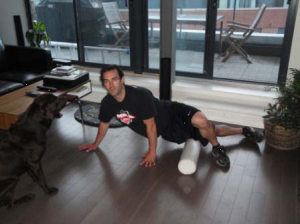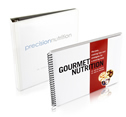Post-Workout Tips
 Yesterday, Dr.John Berardi from Precision Nutrition shared with us his nutrition routine as he prepares for a special event. Today he’ll his describe his unique training methods that help him to stay injury free.
Yesterday, Dr.John Berardi from Precision Nutrition shared with us his nutrition routine as he prepares for a special event. Today he’ll his describe his unique training methods that help him to stay injury free.
Craig Ballantyne : Awesome. Let’s go back to the training and talk about how you have adapted not so much your training, I suppose, but your preparation and your post-workouts treatment in terms of recovery, avoiding injury, preparing for the workouts. How has that changed?
John Berardi: Yeah, fantastic question. Awesome question. And it gets really at the heart of this thing, because for people who’ve done nothing but, if you want to call it fitness training, the orientation to track and field workouts is completely different. I suspect that’s why you asked the question, because of your experience with athletes, Craig. Whereas, with most going to the gym type of workouts, you kind of get there, you slog your way through a little warm-up, 10 minutes, 15 minutes, whatever it might be. You’re just trying to get to the workout. That’s where you lift the weights or do the circuits, the conditioning.
The track and field stuff, it’s completely opposite. I spend probably an hour warming up, and doing stretching and technique drills. And man, it’s tough in the beginning because you think, oh, you’re going for a sprint workout. You’re going to sprint a lot. And you spend the entire first hour just not sprinting. You’re like, “What are you doing?” I’ll bring friends out for a sprint workout with me and they’re like, “Well, when do we run?” I’m like, “Oh yeah, that’s five minutes at the end.”
So, it’s a lot of technical stuff in the beginning, a lot of warm-up, a lot of preparation, prehab if people want to call it that, dynamic stretching, there’s static stretching involved. And you basically spend a lot, a lot of time preparing the body to work at an extremely high intensity, which is what sprinting is, for just a short period of time.
So, for my track workouts it’s literally an hour of a “warm-up and technical session”, and then maybe 15, 20, maybe 30 minutes of actual sprint work, depending on the volume and the intensity. Then your recovery modalities at the end are really, really critical.
For me, I do some foam rolling. I do sauna and steam. I do contrast showers after that. So, normally I’ll roll for a little bit. I’ll hit a steam for 10 minutes, a sauna for 10 minutes and then I’ll do contrast showers. That just basically means you get in the shower and you turn it on as cold as it gets, and you tighten up and you just blast through it for five minutes.
Then you go to warm and then you take off.
Then I also have a manual therapist, an ART guy, who is a chiropractor and he also does shockwave therapy and acupuncture. I see him once or twice a week as well. This is all just preventative maintenance stuff.
The demands of sprinting are so high that if you expect to train for real, you just can’t do it unless you’re 17 years old and have phenomenal recovery, or you have a secret chemist in the background manufacturing compounds for you. Without all this preparation and recovery oriented stuff it just doesn’t work.
On the nutritional side, I think diet is pretty important here. But I also use a host of things that help me with recovery supplement wise. One thing that I think is really, really useful is something by Labrada Nutrition called Sorenzyme. And it’s a host of enzymes that, theoretically at least, are supposed to, instead of just helping with the digestion of your food, you’re supposed to take them on an empty stomach so they can actually act throughout the body to manage inflammation, to manage the hormonal response to exercise, to manage the immune response. I feel like they make a big difference. They’re basically marketed to reduce muscle soreness for weightlifters. But I think they have a really good impact for people in sports who are training this kind of way.
I also take some things like curcumin, which is an anti-inflammatory, and stuff like that to just kind of manage these small micro traumas and injuries that occur out on the track. And again, if you’re younger, if you’re 17 or 18, whatever, you probably don’t need to do any of this. I certainly didn’t when I was in high school and I was running. But when you’re 40, it’s a whole different ballgame. So you need to really, really put the pedal to the metal on recovery, technique, mobility.
So the relationship between preparation and recovery to work almost flips. When you’re a young kid, there’s a lot of work, very little preparation and recovery. As you get older these types of things sort of meet in the middle. And then when you get to my age, they have to flop. You have to spend most of your time on preparation recovery and a little bit of time on the workout spec.
And that for me was a huge revelation. In fact, I have a daughter, she’s two years old and she goes to gymnastics. I’ve watched how slowly they progress her through different techniques and skills. And I learn so much just watching that, because you think, “How do these girls in the Olympics in gymnastics, how do they get trained to the point where they can do the uneven bars and they can do a floor routine? They’re upside down and twisting and flipping and they’re high in the air. How are they not frightened?
How do you prepare someone from day zero where they’ve never even gone upside down, to that? What’s the path?” And it’s just a very, very, very slow cautious and controlled progression. So it’s from no aptitude to world class aptitude. What’s in between? And it’s just this slow progression.
And watching that gave me just a tremendous insight into what we do as fitness professionals, and how we need to be very conscientious about that specific thing. What is the progression we’re taking clients through? I applied it to myself in track and field. But it’s something we’re spending a lot of time at Precision Nutrition doing on the nutrition front.
The old days when you’d walk into a gym and someone would say, “Oh yeah, I want to get in shape.” You’d start working with them as a personal trainer. And then you’d hand them a meal plan. It’s a very interesting dichotomy there. There is some irony to it.
On the training side you’re starting with them as a beginner. And if you’re any good, you’re taking them through a progression. So on day one it should be a shorter workout. You should progress them through less complex movements, and over time build them up to more complex movements.
But on the nutrition front people are giving them the most complicated thing on day one. “Here’s your meal plan, go for it.” No progression. No development. So that’s what we’ve been spending a lot of time at PN working on.
How do we use the principles of progression used in sports, in personal training, in any physical domain, and apply it to nutrition? What are the progressions? What’s the first step? If I wanted to teach someone a power clean or a snatch I wouldn’t just give them the bar and say, “Let her rip. Here, watch this guy do it and you try it.” No, you’re going to chunk it out.
So that’s what we’ve been spending a lot of time doing with PN. How do we create nutritional progression models like physical progression models, so that people can actually succeed? Rather than giving them the bar, trying to have them flip it over their head, and if they get hurt they get hurt. Or simply, they learn to do it wrong from the beginning and they do it wrong for the rest of their career.
So that’s a lot of what we’ve been working on. I kind of spiraled all off topic there, but I think it all relates in some way.
Craig Ballantyne : Yeah. We’re going to get back to that nutrition progression, which sounds pretty cool. First, can we get that Labrada Sorenzyme in Canada?
John Berardi: Yeah.Actually, yes. I just order it from Bodybuilding.com, and they ship it right out.
Craig Ballantyne : Great, awesome stuff. That’s something I’m looking forward to checking out. And just one last question on the training, I’m not sure if you went over your training schedule per week. So you’re doing three days of training only, or are you doing three days of track work and then a little bit of weight training as well?
John Berardi: I probably work out six days. So typically, depending on how things are structured, it will be three or four days of track work, one or two days of weight training, strength training. And if the schedule is sort of open on the sixth day, I’ll usually do something like anaerobic sprints on the bike. So it will be like a 20-second on, 40-second off bike sprint type of workout, to work basically speed endurance type of thing. If it was summer I probably wouldn’t be doing the bike work at all.
I’d probably be out on the track doing longer distance sprints and tempo work. But because it’s the winter and I only have access to a small indoor facility for my sprint work, I’ll do bike sprints instead.
So I’m just kind of working with the environment that we have up here.
Craig Ballantyne : Okay, perfect! We’ll be back tomorrow with Dr. Berardi as he talks about his experiment with intermittent fasting.
Craig Ballantyne, CTT
Certified Turbulence Trainer